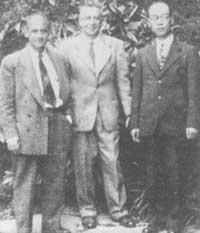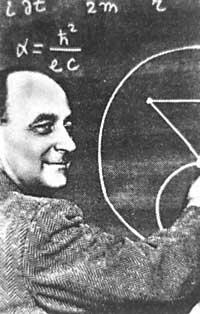Nobel Laureates 1994
1994/11/01 Barrenetxea, Tere - Elhuyar Fundazioa Iturria: Elhuyar aldizkaria
George A. Olah Physics
Bertram Brockhouse
Clifford Schull
Physiology and
Medicine
Alfred Gilman
Martin Rodbell
George A. Olah, a 67-year-old American chemist, has won this year's Nobel Prize in Chemistry.
In 1965 Olah first demonstrated that non-metal atoms, and especially carbon atoms, could have a positive electrical charge, forming structures called carbocations. In that year his team of researchers isolated and characterized the first stable carbohydrate.
The carbon atom, when found in organic molecules, is associated with four other atoms (as if it had four arms) forming structures without electric charge. For example, the natural gas that we will soon use to heat our homes contains a molecule of CH 4 called methane. If this molecule is eliminated from a hydrogen atom, a “brazed molecule” of positive electric charge CH 3 + is formed, which has only three bonds (three arms). But this process is nothing simple, and it was possible thanks to the new “superrazidos” discovered by Olah. These superrazors are millions of times stronger than sulfuric acid or similar that are used industrially.
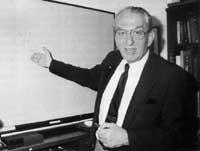
Carbohydrates are very reactive, removed immediately. However, as Olah discovered, under appropriate conditions, they can be used to provide other organic molecules of interest. Thanks to these basic research, important industrial reactions of “reforming” and “cracking” have been developed to extract good quality synthetic gasoline from oil. If natural gasoline were to be extracted directly from the boiled distillation of oil, on the one hand very little would be obtained (only 10 to 15 percent), and on the other, since hydrocarbons obtained long chain molecules, octane levels would be very low, bad combustion and pollutants.
However, if oil distillation is carried out through a series of superrazors invented by Olah, due to carbohydrates, the hydrocarbon molecules are interrupted and branched forming very high octane level gasoline. In this way, on the one hand, oil is used much better with more gasoline and, on the other, being better than the natural combustion of these synthetic gasoline, it is polluted less. Today, gasoline from almost everyone is obtained like this.
In the 1980s, Olah’s team of researchers began looking for cations of other atoms other than carbon or “charged wavy molecules.” In particular, the “silizenium” ions of the silicon atom. These studies have had a great influence on organic chemicals involved in the preparation of complex molecules worldwide.
Olah was born in 1927 in Budapest, Hungary, where, despite being a professor of physics, he moved to the United States in 1957. In addition to his residence and nationality, his scientific activity was totally altered: Organic Chemistry versus Physics. After launching his first basic discoveries, in 1977 he became professor at the prestigious HSI (Hydrocarbon Search Institute) in Southern California and since then he has been working at this research center.
Olah has published hundreds of research in the world's leading scientific journals, always writing deep, elementary and elegant chemistry papers on positively charged molecules. All this has not prevented his great wisdom and humanity (measuring more than 1.90 meters) from being distributed with young chemists. This happened two years ago at a conference very close to Euskal Herria (in the French Arcachon). In it, among other things, in discussions with doctors and young professors of the University of the Basque Country, he presented his latest research project: the preparation and study of organic molecules with two positive charges.
Bertram Brockhouse, a 76-year-old Canadian physicist and 79-year-old Clifford Schull, have been the winners of this year's Nobel Prize in Physics.
The pioneering works carried out in the 40s and 50s were a seed, among others, the Institut Laue-Langevin, the ILL (France) and the gigantic research centers ISIS (Great Britain) built to be used by European scientists. It creates neutrons to investigate the atomic structure of very diverse materials and their dynamics through neutron dispersion techniques.
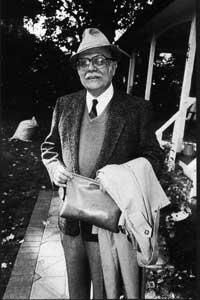
Schull's main contribution has been the development of elastic neutron dispersion techniques to understand the atomic structure. His technique has had a great influence on magnetism and the union of hydrogen in organic and inorganic materials.
His partner Shull and Ernest Wollan (above bego) built in 1948 the neutron diffuser (subatomic fractions without electric charge but with spin) for crystalline samples in the Oak Ridge laboratory (USA). In it neutrons of a narrow energy range are selected from the range of neutrons of wide energy range generated by the fission reactor, diffracting neutrons in a crystal (monochromatic) (varying the direction of movement when crossing the crystal according to the speed). The neutron beam of the same selected energy is directed to the sample object of study to support a new diffraction. Quantifying the number of neutrons that the detector reaches by dispersion angle and time unit, the neutrons dispersed in this second diffraction, can be known the positions of the atomic nuclei of the sample object of study.
That fruitful year Shull and his companions were able to check the ability to separate the different isotopes from a chemical element of neutrons and “see” the lightest element (hydrogen) until then “invisible”. Previously the main experimental technique for the study of the structure of matter was the dispersion of x-rays, but since the probability of dispersion of x-rays proportional to the atomic number of the element, it is impossible to “see” light elements and distinguish elements of paired atomic number. As these two main obstacles can overcome the dispersion of neutrons, a wide open door was opened to study the structure of matter. Since hydrogen is a staple of organic compounds, an important pathway was opened to study organic chemistry and biological macromolecules.
The following year Shull and J. They experimentally demonstrated the antifromagnetism of Smart Manganese Oxide (MnO). This was the pioneering experiment to check the magnetic dispersion of neutrons. It was therefore demonstrated that neutron can be combined with matter in two ways: 1) through intense nuclear interaction with the nucleus and 2) with electrons not paired by spin, i.e. with atomic magnetic moments.
In 1956 he was hired by the Massachusetts Institute of Technology (MIT) and remained until his retirement. Shull's research works followed the same path and until 1970 he published several pioneering works. The polarized neutron spectrometer, built for the first time in 1959, can distinguish and use the “upward” or “downward” neutron spin.
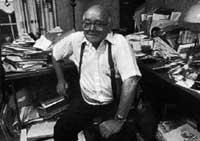
Brockhouse has been awarded for his contribution to the development of non-elastic neutron dispersion techniques. This technique allowed us to investigate the material dynamics of atoms. His technique has had a great influence on the development of transition theories between fluid structure and solid/fluid states.
Brockhouse developed all the experimental work in the Chalk River laboratory. However, from 1962 he was hired by the University of MacMaster. In 1955, Brockhaus built a gauge similar to Wollan and Shull, but in order to study the energies of the diffracted neutrons in the sample, he added to the spectrometer another crystal (analyzer) (forming a three-axis sperctrometer). Thus, in addition to the static structure of matter, one can study the dynamics of atoms and magnetic moments.
The splitter designed by Shull “sees” the cores standing or magnetic moments in a perfect order. But temperature causes atoms and magnetic moments to vibrate around equilibrium positions (microscopic dynamics). Microscopic X-ray dynamics are virtually unreachable, but the energy of thermal neutrons is atomic in order, so it can be easily measured with a three-axis spectrometer.
Brockhouse and his colleagues were very productive in the design of non-elastic dispersion spectrometers, among which are the rotating glass and the flight time spectrometer (the velocity of neutrons (energy) is measured, measuring the time it takes to travel a known stretch). The measures carried out include obtaining the first spectrum of magnos (magnetic moment waves) and dispersion in liquid water.
The field of research, led by Brockhouse and Shull, has crossed the boundaries of nuclear physics and solid state and has spread to other fields of science.
In Euskal Herria there are also two or three research groups that use the giant neutron laboratories ILL and ISIS in Europe, and in 1990 a congress on neutron dispersion was held at the headquarters of the UPV/EHU in Deusto.
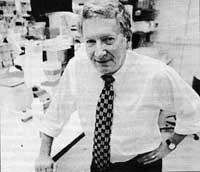
The Nobel Prize in Medicine and Physiology has been awarded to two American researchers: Alfred Gilman and Martin Rodbell for their work on mechanisms of hormonal action.
For an organism to function it is necessary that its components act in a coordinated manner and for this they must know each other. Specifically, cells must be continuously informed of the state of this organism to act in one way or another depending on this situation.
Hormones are the chemical messengers responsible for the integration and biochemical coordination of living beings. The cells respond to the presence of chemical messengers like hormones, modifying some of their activities adapting them to the situation that this message indicates.
Some hormones are incorporated into your target cells. Others remain outside the cell. In the latter case, if the signal left out will influence the biochemical activity of this cell, it is clear that a second messenger must be created within the cell.
In technical language, the transformation of the extracellular signal that brings the hormone into intracellular is called signal transduction. One type of protein involved in the transduction process has been the subject of this year's Nobel Prize study. These proteins are called G proteins, because of their ability to bind guanine nucleotides. These researchers discovered these G proteins and demonstrated their involvement in signal transduction.
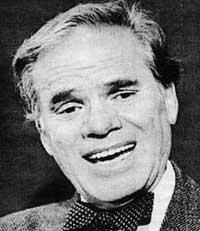
Since then many different G proteins have been isolated. Most of them, more than 1,000, are related to smell and taste. Others are related to neurotransmission, regulation of glucose levels and blood pressure or kidney function. Therefore, a good activity of G proteins and proteins such as these are of great importance to living beings and some diseases are caused by the malfunction of these proteins. For example, cholera and dome toxins add to G proteins and modify their activity by developing the disease.
They have also been linked to cancer through other discoveries, as some G proteins can convert normal cells into cancer cells. In light of this data, it can be concluded that G proteins also have to do with cell reproduction control. This path can generate many studies for oncologists in the coming years.
The winners, Gilman and Rodbell, are Americans. Alfred Gilman, 53, works in the department of pharmacology at the University of Texas. Martin Rodbell, 69, leads the National Institute of Environmental Health Sciences in North Carolina.

Gai honi buruzko eduki gehiago
Elhuyarrek garatutako teknologia




